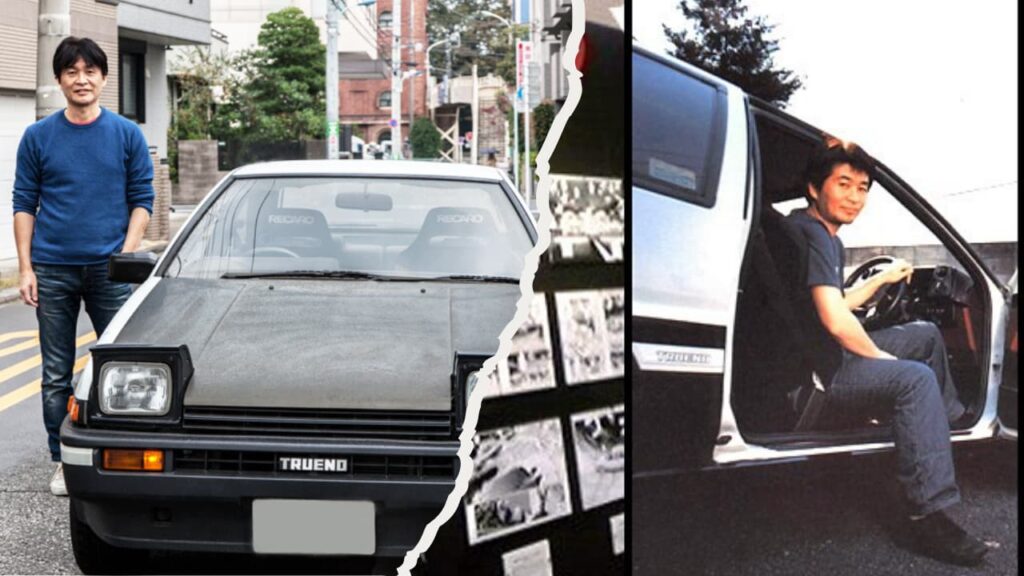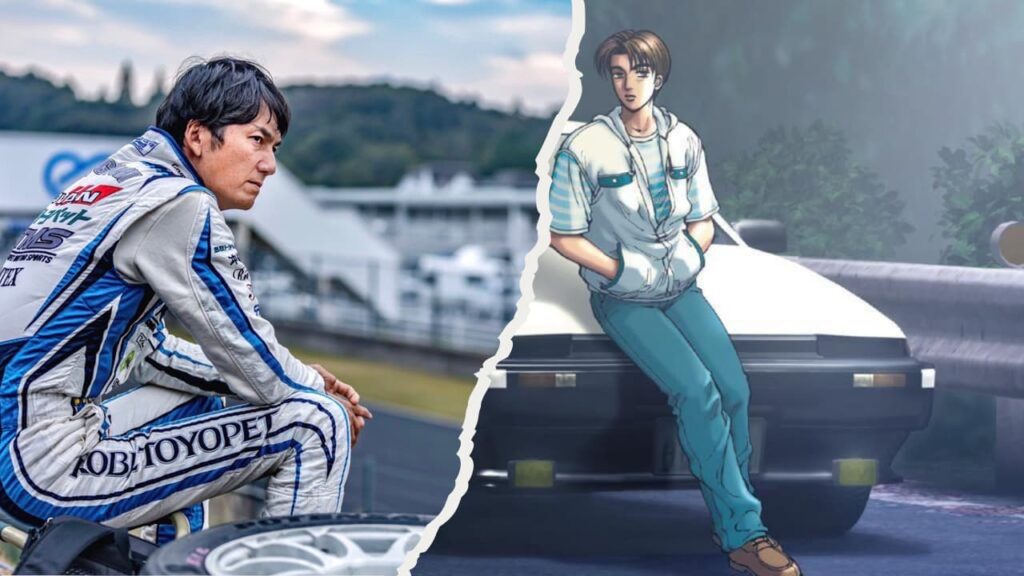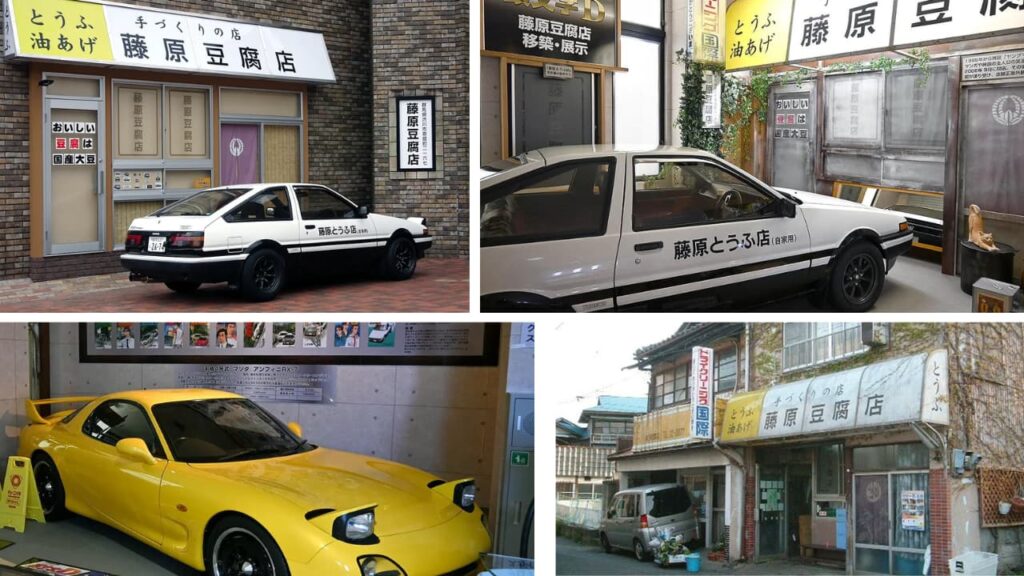Manga artist Shuichi Shigeno, born on March 8, 1958, in Matsunoyama, Tokamachi, Niigata Prefecture, is the genius behind one of the best and iconic manga anime series Initial D.
After debuting in 1981 with Oretachi Zecchou, he achieved fame with Baribari Densetsu, which ignited a motorcycle boom.
However, it was Initial D—serialized in Kodansha’s Weekly Young Magazine from 1995 to 2013 and selling over 48 million copies worldwide—that revolutionized street racing culture.
Shigeno’s fascination with cars, inspired by his father and the Initial D anime, fuels this legendary tale that has inspired countless adaptations, from anime to video games.
Now, let’s dive into some unknown facts about Initial D that even the most dedicated fans may not know!
1. Author Shigeno bought his AE86 Toyota Sprinter Trueno (Hachiroku) with the royalties from “Bari Bari Densetsu”

Bari Bari Densetsu was Shigeno Sensei’s first major hit manga. Although he had written many works before, they hadn’t gained much success.
However, when Bari Bari Densetsu sold well and he received a substantial sum from the first edition royalties, he decided to buy a car without considering the consequences. And yes it was ‘AE86 Toyota Sprinter Trueno’.
I was reading an interview with Shigeno-sensei a while back and also found out this interesting story: when he bought this as his first car, he didn’t really put much thought into it.
He didn’t know much about cars, but unlike motorcycles, a car was great in the rain and allowed him to talk to his girlfriend while driving. So, he figured any car would do for that purpose. He just wanted something stylish rather than an old-fashioned sedan.
While he was browsing around, he noticed a Toyota Auto store along Meguro-dori, a road he often rode his motorcycle on. They had a sign for the new model of the Sprinter Trueno.
He thought, if it wasn’t too expensive, he might buy it. So, he walked into the store. The Sprinter Trueno AE86 looked stylish and cool, and it wasn’t particularly expensive, so he thought it would be a great choice.
2. Keiichi Tsuchiya, famously known as Japan’s ‘Drift King’ and a pioneer in the drifting scene, served as an advisor for the show

Keiichi Tsuchiya, also known as the Drift King, is a key figure in the appeal of both the Hachiroku and Initial D. It’s often said that Tsuchiya served as the inspiration for Fujiwara Takumi.
Like Takumi, Tsuchiya honed his skills on mountain passes and popularized drifting with his Hachiroku, making the comparison between the two quite fitting.
After praising the manga Initial D, which began serialization in 1995, on his radio show, Tsuchiya had a conversation with the manga’s author, Shuichi Shigeno, in a 1997 magazine interview.
This led to a lasting friendship between them. When the animated version of Initial D started in 1998, Tsuchiya played a significant role in the production.
He supervised the battle scenes, drove the cars, and recorded their sounds for the series. He even made a brief cameo in episode 24 during a phone call to Bunta Fujiwara.
3. D1 Grand Prix champion Nobuteru Taniguchi, who was involved in the anime’s production, has a story remarkably similar to the series’ protagonist

With the involvement of professional racers Keiichi Tsuchiya and Nobuteru Taniguchi in the production, the powerful drifting scenes and realistic depictions of the work have captured the hearts of readers.
What’s even more surprising is that Nobuteru Taniguchi actually drove an AE86 Trueno, drifted on mountain passes, and worked at a tofu shop called “Kubota Foods,” delivering tofu from 4 a.m. to noon. It sounds just like something out of “Initial D,” doesn’t it?
Taniguchi’s story closely mirrored that of Takumi Fujiwara, the main character from the manga. Around the same time Taniguchi was making a name for himself in racing, “Initial D” began serialization, and people even wondered if he was the model for the manga.
It turns out it was all just a coincidence. However, years later, when he met the anime production team, they brought him on board to work on the movie version of “Initial D.”
His role involved recording the sounds of all the cars that appeared in the anime, including drifting them around Tsukuba Circuit to capture the perfect audio!
4. The Fujiwara Tofu Shop, which was the model for the series, actually exists in Shibukawa City, Gunma Prefecture

The Fujiwara Tofu Shop, known from Initial D, was once a real location in Shibukawa, Gunma Prefecture. However, it didn’t have the iconic driveway or AE86.
The building was demolished in 2009 due to land redevelopment, and no visible trace of the shop remains today. The original signboards, though, are preserved and on display at the Ikaho Toy and Doll Car Museum.
5. Shibukawa City Embraced Anime Tourism Through “Initial D” Collaboration
Shibukawa City is actively promoting anime tourism, capitalizing on the global popularity of Initial D. Fans of the series can explore locations tied to the anime and immerse themselves in its real-world setting.
Key spots include mountain passes from the famous races, Takumi’s family home, and the place where he went on a date with Natsuki. Explore these real-world settings and more by visiting the official Shibukawa City website.
6. Shuichi Shigeno: The Motorcycle Enthusiast Is Also Famous for His Motorcycle Manga
Shuichi Shigeno, best known for the touge battle manga Initial D, played a major role in introducing drifting to the U.S. However, before the iconic AE86 made its mark, Shigeno created Bari Bari Densetsu, an award-winning motorcycle racing manga.
Running from 1983 to 1991 in Weekly Shonen Magazine, BariDen shares many parallels with Initial D, from its realistic portrayal of vehicles and riding styles to its use of real-world locations.
The series, which sold over 26 million copies and won the Kodansha Manga Award in 1985, is often seen as a precursor to Initial D. Fans of Shigeno’s work should definitely explore this influential predecessor.
7. The “Drift Tax”: How Initial D Boosted the Popularity of JDM Cars in America
When Initial D first aired in the U.S., interest in imported JDM cars surged. Models like the Mazda RX-7 and Nissan Silvia became favorites among tuners and drifters. As demand grew, so did the prices of these vehicles, a phenomenon now known as the “Drift Tax.”
8. In Initial D, Akina Mountain is based on Haruna Mountain in Gunma Prefecture.
In Initial D, Akina Mountain is famed as the primary downhill racing course, but it’s actually inspired by Haruna Mountain in Gunma Prefecture. Renowned for its winding roads and sharp turns, Haruna Mountain has become a popular destination for fans and drifting enthusiasts alike.
The mountain’s challenging terrain perfectly captures the thrilling touge battles depicted in the anime, inviting visitors to experience the adrenaline of racing on the very roads that inspired Takumi Fujiwara’s legendary journeys. For those looking to immerse themselves in the world of Initial D, a visit to Haruna Mountain is an unforgettable experience.
9. The transition from brand stickers to generic logos presented a significant challenge for the animation studio in adapting Initial D
In the original Initial D comic, the cars prominently featured brand stickers on the drivers’ doors, showcasing well-known names like Bomex, Greddy, and HKS.
However, when adapting the manga into an anime, the animation studio faced challenges in acquiring licenses for these brands and ultimately replaced them with generic alternatives such as Max Speed and Shift Down.
This change not only altered the visual authenticity of the racing scenes but also reflected the broader struggle of anime adaptations to navigate brand partnerships.
Despite these modifications, Initial D still captured the essence of car culture, resonating with fans around the world.
10. Mount Myogi: Initial D’s Iconic Hillclimb Battle place is actually a real life Motorcycle Racing Hub
In Initial D, Mount Myogi is the backdrop for the intense hillclimb battle between Keisuke and Nakazato. However, this mountain is more renowned for its motorcycle riders than its drifting scene. Each year, an official motorcycle race takes place at Myogi, attracting riders from across the region.
This annual event highlights the mountain’s reputation as a premier destination for motorsport enthusiasts, blending the thrill of racing with the stunning natural scenery.
We hope you enjoyed this dive into the intriguing connections between Initial D and its real-world inspirations. Keep an eye out for more captivating trivia and insights from the world of anime and motorsport!



